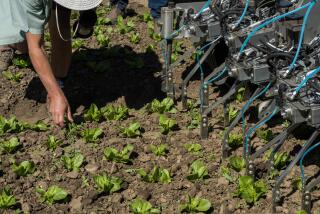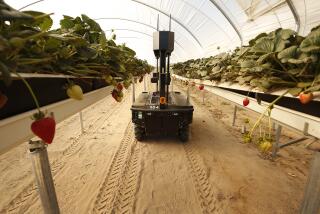High-Tech Tractors Help Farmers Reap Profits : Agriculture: Gadgets, including radar, monitor engine performance and rate of fuel, chemical use. Even more changes in equipment lie ahead.
- Share via
GREENFIELD, Iowa — Features to check out when your farmer-friend invites you to help shop for a new $100,000 tractor:
Enclosed, climate-controlled cab with AM-FM stereo and business-band radio or cellular phone.
* Power-adjusted, deep-cushioned seat with armrests for days in the field that start before sunrise and end well past sunset.
* Digital instrumentation panels to monitor engine performance and farming progress.
* Radar.
Radar?
Radar for tractors?
Whatever happened to the no-frills workhorse with a metal bicycle-style seat--and, on the deluxe model, an umbrella to shade the driver?
“It’s like sitting in the office,” Mike Dolan says of his 15-hour days he spends in the cab of an $87,000 John Deere 8560 four-wheel drive tractor, preparing fields for planting in the gentle hills outside this southwest Iowa community.
“You come out of the fields with this thing and you’re almost halfway relaxed,” says his father, Don.
Don Dolan recalls starting farming with a 1956 open-cab tractor that cost $2,600, much less than the $4,080 it would take just to replace the eight huge tires on his son’s new tractor.
What was spring fieldwork like in the equipment of 35 years ago?
“Terrible. You were out in the dirt, in the cold all day long,” Don Dolan says.
But then came the “smart tractor,” costing anywhere from $51,000 to $105,000. Its gadgets are designed to take the drudgery out of fieldwork while making farmers more efficient and better managers of seed and chemicals.
It’s more than “a bell and whistle or frill,” said Mark Hanna, an extension service agricultural engineer at Iowa State University.
“Farming you used to do with your back, now you use your mind,” says Don Dolan.
Take the radar option, which costs about $500. Radar on tractors is mounted under the body and is used to accurately calculate ground speed.
Anyone who has driven a car on ice and seen the speedometer rise rapidly as the car fails to move knows dashboard gauges can be fooled by rapid wheel movement on slick surfaces. In a tractor, those distortions are caused by tractor tires slipping on soil, or slippage.
Some slippage is necessary to get the most efficient pull from a tractor with least stress on the drive train, manufacturers say. Too little slippage means too much weight, compacting the soil and reducing fuel economy. Too much slippage and the farmer also wastes fuel and also wears out tires and puts too many chemicals on the ground.
With ground-water contamination by farm chemicals becoming more of a public health worry, farmers now have environmental as well as bottom-line considerations in trying to control chemical use, Hanna says.
Larree Imboden, who farms 1,700 acres with his son near the central Iowa community of Dexter, has the radar option on the John Deere model 4455 tractor that he bought in February.
By punching in the width of the tool he is pulling on the console and using the radar and other instrumentation, Imboden gets a readout on the area he has covered and his work rate. He can calculate how long it will take to complete the field, and he also can accurately measure off the land he leaves idle under government farm programs.
The instrumentation also makes it easier to trouble-shoot engine problems, and design changes make for easier access to the engine.
The new gadgets require new skills for farmers and farmhands.
While you don’t have to be a jet pilot or rocket scientist to take the controls, it does take the same kind of skills used to program a videotape recorder or operate a microwave oven.
“When your livelihood depends on this. When it means extra money out of your pockets, all of a sudden you get interested very quickly,” says Iowa State’s Hanna. “Like the microwave or indoor plumbing, once you get it and get used to it, it’s a useful tool.”
More changes lie ahead.
Researchers at Iowa State University are studying farm applications for the global positioning satellites that helped allies fight the Persian Gulf War.
By mapping fields by their yield potential and soil characteristics, satellite systems used with smart tractors could enable farmers to vary applications of seed, chemicals and fertilizer in midfield.
Guidance systems also are being developed to make it easier for farmers to drive tractors hauling wide implements as they try to weed fields without destroying cash crops.
As farms become bigger and world markets become more competitive, holding down the prices farmers receive for their crops, such equipment becomes an important tool for increasing productivity.
“The changes have been pretty drastic,” Imboden says. “We’re farming the same amount of ground that probably eight farmers were farming back when we started.”
More to Read
Inside the business of entertainment
The Wide Shot brings you news, analysis and insights on everything from streaming wars to production — and what it all means for the future.
You may occasionally receive promotional content from the Los Angeles Times.










